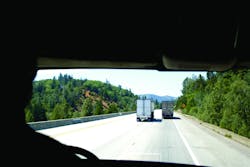Push on to test truck drivers for drugs via hair-testing
While the National Transportation Safety Board’s (NTSB) newly released report on actions needed to eliminate alcohol-impaired driving by motorists has naturally garnered much media attention this week, the American Trucking Assns.(ATA) is prodding the Dept. of Transportation to take action to further curb truck impaired driving by truckers.
The day before the NTSB report came out, ATA said its president & CEO Bill Graves wrote to Secretary of Transportation Ray LaHood to again urge DOT to allow motor carriers to collect hair samples for DOT-required drug testing in lieu of the currently mandated urine-testing process.
“ATA knows for a fact that thousands of truck drivers who have failed hair tests . . . have obtained driving positions with other carriers because they were able to pass DOT-authorized urine tests,” Graves wrote in the May 13th letter.
“All we are asking is for DOT to allow this industry to use the best available tools under the DOT-mandated drug- and-alcohol testing program to make sure our roads are safe for all motorists,” he added.
Hair-testing, it should be noted, does not reveal the presence of alcohol, only various drugs.
“The Truckload Carriers Assn. [TCA} does support the pursuit of regulatory and/or legislative changes to the FMCSA and/or DOT regulations to permit alternative specimens, such as hair, to be used to comply with federal drug testing requirements,” David Heller, TCA’s director of safety & policy, told FleetOwner.
Hair-testing, it should be noted, does not reveal the presence of alcohol, only various drugs.
NTSB on Tuesday released a lengthy report that delivers a list of specific recommendations to reduce alcohol-impaired driving on the nation’s roads. The most notable measure emphasized by the Board is to further reduce the current blood alcohol concentration (BAC) limit of 0.08 to 0.05 for motorists.
Of course, for some time there has been an even lower nationwide BAC limit of 0.04 in place along with random drug and alcohol testing for drivers of commercial vehicles.
But when it comes to motorists in general, NTSB is strongly convinced that much more needs to be done to reduce alcohol-impaired driving in this country.
NTSB pointed out that “although impaired driving injuries, fatalities, and fatality rates in the United States have significantly decreased over the past several decades, the pace of these reductions has slowed since the mid-1990s; and alcohol-impaired driving continues to contribute to thousands of fatalities and tens of thousands of serious injuries each year. Based on its review of research tracking impaired driving behaviors and attitudes, the NTSB concludes that the public generally believes that driving after drinking alcohol poses a significant threat to safety; however, many people continue to drive after drinking.”
That being its position, NTSB recommends that the States take these specific steps:
· Reduce the per se [in itself] BAC limit for all drivers to 0.05
· Conduct high-visibility enforcement of impaired-driving laws and incorporating passive alcohol-sensing technology into enforcement efforts
· Expand the use of in-vehicle devices [ignition interlocks] to prevent operation by impaired drivers
· Use Driving While Intoxicated (DWI) courts and other programs to reduce recidivism by repeat DWI offenders
· Establish measurable goals for reducing impaired driving and tracking progress toward those goals
On the federal side, NTSB recommends that the National Highway Traffic Safety Administration (NHTSA) do the following to support State efforts:
· Seek authority to award incentive grants to states for establishing per se BAC limits of 0.05 or lower
· Establish best practices for alcohol ignition-interlock programs and create incentives to encourage States to adopt these practices
· Develop and disseminate to the States best practices for DWI courts
“By taking these recommended comprehensive actions that have demonstrated their effectiveness,” NTSB stated, “the United States can accelerate progress toward reaching zero alcohol-impaired driving crashes, injuries, and fatalities.”
“All motorists should support reducing the instances of impaired driving,” observed ATAT’s Graves. “The trucking industry is held, and holds itself, to a higher standard and we are encouraged by NTSB’s recommendations to bolster efforts to reduce drunk and drugged driving for all motorists.”
Regardless of the legal BAC limits set by the States, “trucking is a zero-tolerance industry,” pointed out TCA’s Heller. “So carriers have policies of no alcohol in drivers’ systems while they are operating a commercial motor vehicle.”
